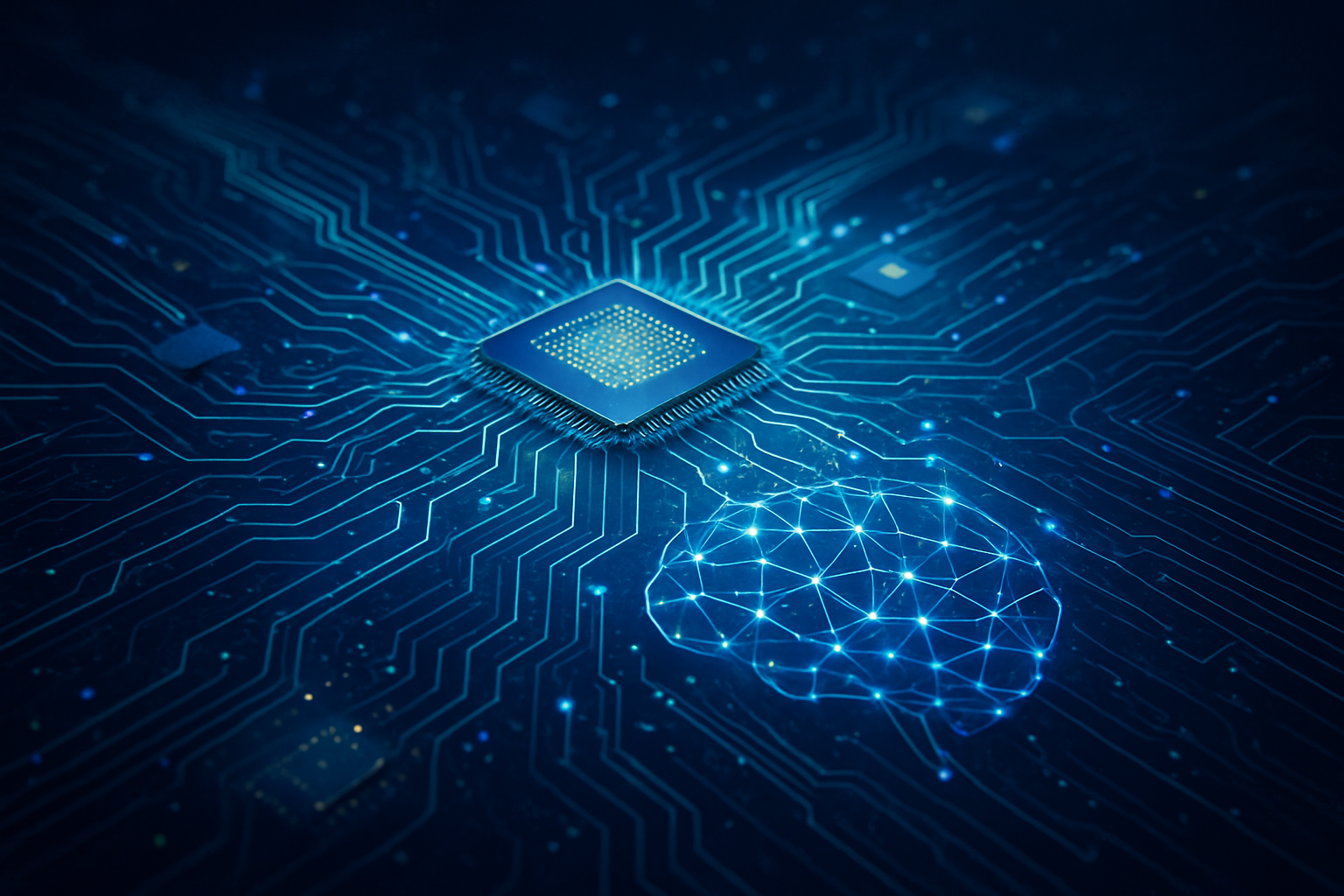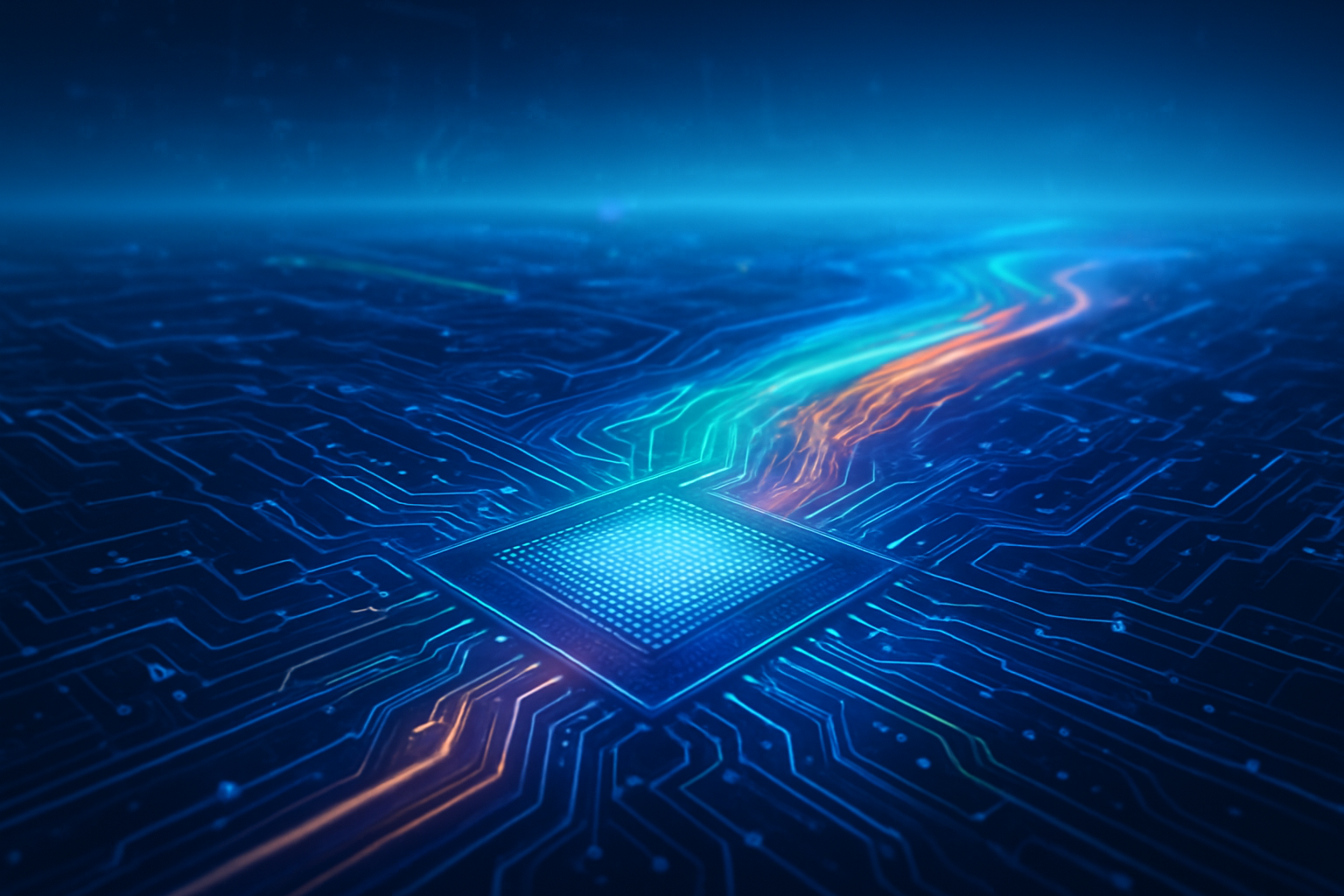The relentless march of artificial intelligence, with its insatiable demand for computational power and energy efficiency, is pushing the foundational material of the digital age, silicon, to its inherent physical limits. As traditional silicon-based semiconductors encounter bottlenecks in performance, heat dissipation, and power consumption, a profound revolution is underway. Researchers and industry leaders are now looking to a new generation of exotic materials and groundbreaking architectures to redefine AI chip design, promising unprecedented capabilities and a future where AI's potential is no longer constrained by a single element.
This fundamental shift is not merely an incremental upgrade but a foundational re-imagining of how AI hardware is built, with immediate and far-reaching implications for the entire technology landscape. The goal is to achieve significantly faster processing speeds, dramatically lower power consumption crucial for large language models and edge devices, and denser, more compact chips. This new era of materials and architectures will unlock advanced AI capabilities across various autonomous systems, industrial automation, healthcare, and smart cities.
Redefining Performance: Technical Deep Dive into Beyond-Silicon Innovations
The landscape of AI semiconductor design is rapidly evolving beyond traditional silicon-based architectures, driven by the escalating demands for higher performance, energy efficiency, and novel computational paradigms. Emerging materials and architectures promise to revolutionize AI hardware by overcoming the physical limitations of silicon, enabling breakthroughs in speed, power consumption, and functional integration.
Carbon Nanotubes (CNTs)
Carbon Nanotubes are cylindrical structures made of carbon atoms arranged in a hexagonal lattice, offering superior electrical conductivity, exceptional stability, and an ultra-thin structure. They enable electrons to flow with minimal resistance, significantly reducing power consumption and increasing processing speeds compared to silicon. For instance, a CNT-based Tensor Processing Unit (TPU) has achieved 88% accuracy in image recognition with a mere 295 μW, demonstrating nearly 1,700 times more efficiency than Google's (NASDAQ: GOOGL) silicon TPU. Some CNT chips even employ ternary logic systems, processing data in a third state (beyond binary 0s and 1s) for faster, more energy-efficient computation. This allows CNT processors to run up to three times faster while consuming about one-third of the energy of silicon predecessors. The AI research community has hailed CNT-based AI chips as an "enormous breakthrough," potentially accelerating the path to artificial general intelligence (AGI) due to their energy efficiency.
2D Materials (Graphene, MoS2)
Atomically thin crystals like Graphene and Molybdenum Disulfide (MoS₂) offer unique quantum mechanical properties. Graphene, a single layer of carbon, boasts electron movement 100 times faster than silicon and superior thermal conductivity (~5000 W/m·K), enabling ultra-fast processing and efficient heat dissipation. While graphene's lack of a natural bandgap presents a challenge for traditional transistor switching, MoS₂ naturally possesses a bandgap, making it more suitable for direct transistor fabrication. These materials promise ultimate scaling limits, paving the way for flexible electronics and a potential 50% reduction in power consumption compared to silicon's projected performance. Experts are excited about their potential for more efficient AI accelerators and denser memory, actively working on hybrid approaches that combine 2D materials with silicon to enhance performance.
Neuromorphic Computing
Inspired by the human brain, neuromorphic computing aims to mimic biological neural networks by integrating processing and memory. These systems, comprising artificial neurons and synapses, utilize spiking neural networks (SNNs) for event-driven, parallel processing. This design fundamentally differs from the traditional von Neumann architecture, which separates CPU and memory, leading to the "memory wall" bottleneck. Neuromorphic chips like IBM's (NYSE: IBM) TrueNorth and Intel's (NASDAQ: INTC) Loihi are designed for ultra-energy-efficient, real-time learning and adaptation, consuming power only when neurons are triggered. This makes them significantly more efficient, especially for edge AI applications where low power and real-time decision-making are crucial, and is seen as a "compelling answer" to the massive energy consumption of traditional AI models.
3D Stacking (3D-IC)
3D stacking involves vertically integrating multiple chip dies, interconnected by Through-Silicon Vias (TSVs) and advanced techniques like hybrid bonding. This method dramatically increases chip density, reduces interconnect lengths, and significantly boosts bandwidth and energy efficiency. It enables heterogeneous integration, allowing logic, memory (e.g., High-Bandwidth Memory – HBM), and even photonics to be stacked within a single package. This "ranch house into a high-rise" approach for transistors significantly reduces latency and power consumption—up to 1/7th compared to 2D designs—which is critical for data-intensive AI workloads. The AI research community is "overwhelmingly optimistic," viewing 3D stacking as the "backbone of innovation" for the semiconductor sector, with companies like TSMC (NYSE: TSM) and Intel (NASDAQ: INTC) leading in advanced packaging.
Spintronics
Spintronics leverages the intrinsic quantum property of electrons called "spin" (in addition to their charge) for information processing and storage. Unlike conventional electronics that rely solely on electron charge, spintronics manipulates both charge and spin states, offering non-volatile memory (e.g., MRAM) that retains data without power. This leads to significant energy efficiency advantages, as spintronic memory can consume 60-70% less power during write operations and nearly 90% less in standby modes compared to DRAM. Spintronic devices also promise faster switching speeds and higher integration density. Experts see spintronics as a "breakthrough" technology capable of slashing processor power by 80% and enabling neuromorphic AI hardware by 2030, marking the "dawn of a new era" for energy-efficient computing.
Shifting Sands: Competitive Implications for the AI Industry
The shift beyond traditional silicon semiconductors represents a monumental milestone for the AI industry, promising significant competitive shifts and potential disruptions. Companies that master these new materials and architectures stand to gain substantial strategic advantages.
Major tech giants are heavily invested in these next-generation technologies. Intel (NASDAQ: INTC) and IBM (NYSE: IBM) are leading the charge in neuromorphic computing with their Loihi and NorthPole chips, respectively, aiming to outperform conventional CPU/GPU systems in energy efficiency for AI inference. This directly challenges NVIDIA's (NASDAQ: NVDA) GPU dominance in certain AI processing areas, especially as companies seek more specialized and efficient hardware. Qualcomm (NASDAQ: QCOM), Samsung (KRX: 005930), and NXP Semiconductors (NASDAQ: NXPI) are also active in the neuromorphic space, particularly for edge AI applications.
In 3D stacking, TSMC (NYSE: TSM) with its 3DFabric and Samsung (KRX: 005930) with its SAINT platform are fiercely competing to provide advanced packaging solutions for AI accelerators and large language models. NVIDIA (NASDAQ: NVDA) itself is exploring 3D stacking of GPU tiers and silicon photonics for its future AI accelerators, with predicted implementations between 2028-2030. These advancements enable companies to create "mini-chip systems" that offer significant advantages over monolithic dies, disrupting traditional chip design and manufacturing.
For novel materials like Carbon Nanotubes and 2D materials, IBM (NYSE: IBM) and Intel (NASDAQ: INTC) are investing in fundamental materials science, seeking to integrate these into next-generation computing platforms. Google DeepMind (NASDAQ: GOOGL) is even leveraging AI to discover new 2D materials, gaining a first-mover advantage in material innovation. Companies that successfully commercialize CNT-based AI chips could establish new industry standards for energy efficiency, especially for edge AI.
Spintronics, with its promise of non-volatile, energy-efficient memory, sees investment from IBM (NYSE: IBM), Intel (NASDAQ: INTC), and Samsung (KRX: 005930), which are developing MRAM solutions and exploring spin-based logic devices. Startups like Everspin Technologies (NASDAQ: MRAM) are key players in specialized MRAM solutions. This could disrupt traditional volatile memory solutions (DRAM, SRAM) in AI applications where non-volatility and efficiency are critical, potentially reducing the energy footprint of large data centers.
Overall, companies with robust R&D in these areas and strong ecosystem support will secure leading market positions. Strategic partnerships between foundries, EDA tool providers (like Ansys (NASDAQ: ANSS) and Synopsys (NASDAQ: SNPS)), and chip designers are becoming crucial for accelerating innovation and navigating this evolving landscape.
A New Chapter for AI: Broader Implications and Challenges
The advancements in semiconductor materials and architectures beyond traditional silicon are not merely technical feats; they represent a fundamental re-imagining of computing itself, poised to redefine AI capabilities, drive greater efficiency, and expand AI's reach into unprecedented territories. This "hardware renaissance" is fundamentally reshaping the AI landscape by enabling the "AI Supercycle" and addressing critical needs.
These developments are fueling the insatiable demand for high-performance computing (HPC) and large language models (LLMs), which require advanced process nodes (down to 2nm) and sophisticated packaging. The unprecedented demand for High-Bandwidth Memory (HBM), surging by 150% in 2023 and over 200% in 2024, is a direct consequence of data-intensive AI systems. Furthermore, beyond-silicon materials are crucial for enabling powerful and energy-efficient AI chips at the edge, where power budgets are tight and real-time processing is essential for autonomous vehicles, IoT devices, and wearables. This also contributes to sustainable AI by addressing the substantial and growing electricity consumption of global computing infrastructure.
The impacts are transformative: unprecedented speed, lower latency, and significantly reduced power consumption by minimizing the "von Neumann bottleneck" and "memory wall." This enables new AI capabilities previously unattainable with silicon, such as molecular-level modeling for faster drug discovery, real-time decision-making for autonomous systems, and enhanced natural language processing. Moreover, materials like diamond and gallium oxide (Ga₂O₃) can enable AI systems to operate in harsh industrial or even space environments, expanding AI applications into new frontiers.
However, this revolution is not without its concerns. Manufacturing cutting-edge AI chips is incredibly complex and resource-intensive, requiring completely new transistor architectures and fabrication techniques that are not yet commercially viable or scalable. The cost of building advanced semiconductor fabs can reach up to $20 billion, with each new generation demanding more sophisticated and expensive equipment. The nascent supply chains for exotic materials could initially limit widespread adoption, and the industry faces talent shortages in critical areas. Integrating new materials and architectures, especially in hybrid systems combining electronic and photonic components, presents complex engineering challenges.
Despite these hurdles, the advancements are considered a "revolutionary leap" and a "monumental milestone" in AI history. Unlike previous AI milestones that were primarily algorithmic or software-driven, this hardware-driven revolution will unlock "unprecedented territories" for AI applications, enabling systems that are faster, more energy-efficient, capable of operating in diverse and extreme conditions, and ultimately, more intelligent. It directly addresses the unsustainable energy demands of current AI, paving the way for more environmentally sustainable and scalable AI deployments globally.
The Horizon: Envisioning Future AI Semiconductor Developments
The journey beyond silicon is set to unfold with a series of transformative developments in both materials and architectures, promising to unlock even greater potential for artificial intelligence.
In the near-term (1-5 years), we can expect to see continued integration and adoption of Gallium Nitride (GaN) and Silicon Carbide (SiC) in power electronics, 5G infrastructure, and AI acceleration, offering faster switching and reduced power loss. 2D materials like graphene and MoS₂ will see significant advancements in monolithic 3D integration, leading to reduced processing time, power consumption, and latency for AI computing, with some projections indicating up to a 50% reduction in power consumption compared to silicon by 2037. Ferroelectric materials will gain traction for non-volatile memory and neuromorphic computing, addressing the "memory bottleneck" in AI. Architecturally, neuromorphic computing will continue its ascent, with chips like IBM's North Pole leading the charge in energy-efficient, brain-inspired AI. In-Memory Computing (IMC) / Processing-in-Memory (PIM), utilizing technologies like RRAM and PCM, will become more prevalent to reduce data transfer bottlenecks. 3D chiplets and advanced packaging will become standard for high-performance AI, enabling modular designs and closer integration of compute and memory. Silicon photonics will enhance on-chip communication for faster, more efficient AI chips in data centers.
Looking further into the long-term (5+ years), Ultra-Wide Bandgap (UWBG) semiconductors such as diamond and gallium oxide (Ga₂O₃) could enable AI systems to operate in extremely harsh environments, from industrial settings to space. The vision of fully integrated 2D material chips will advance, leading to unprecedented compactness and efficiency. Superconductors are being explored for groundbreaking applications in quantum computing and ultra-low-power edge AI devices. Architecturally, analog AI will gain traction for its potential energy efficiency in specific workloads, and we will see increased progress in hybrid quantum-classical architectures, where quantum computing integrates with semiconductors to tackle complex AI algorithms beyond classical capabilities.
These advancements will enable a wide array of transformative AI applications, from more efficient high-performance computing (HPC) and data centers powering generative AI, to smaller, more powerful, and energy-efficient edge AI and IoT devices (wearables, smart sensors, robotics, autonomous vehicles). They will revolutionize electric vehicles (EVs), industrial automation, and 5G/6G networks. Furthermore, specialized AI accelerators will be purpose-built for tasks like natural language processing and computer vision, and the ability to operate in harsh environments will expand AI's reach into new frontiers like medical implants and advanced scientific discovery.
However, challenges remain. The cost and scalability of manufacturing new materials, integrating them into existing CMOS technology, and ensuring long-term reliability are significant hurdles. Heat dissipation and energy efficiency, despite improvements, will remain persistent challenges as transistor densities increase. Experts predict a future of hybrid chips incorporating novel materials alongside silicon, and a paradigm shift towards AI-first semiconductor architectures built from the ground up for AI workloads. AI itself will act as a catalyst for discovering and refining the materials that will power its future, creating a self-reinforcing cycle of innovation.
The Next Frontier: A Comprehensive Wrap-Up
The journey beyond silicon marks a pivotal moment in the history of artificial intelligence, heralding a new era where the fundamental building blocks of computing are being reimagined. This foundational shift is driven by the urgent need to overcome the physical and energetic limitations of traditional silicon, which can no longer keep pace with the insatiable demands of increasingly complex AI models.
The key takeaway is that the future of AI hardware is heterogeneous and specialized. We are moving beyond a "one-size-fits-all" silicon approach to a diverse ecosystem of materials and architectures, each optimized for specific AI tasks. Neuromorphic computing, optical computing, and quantum computing represent revolutionary paradigms that promise unprecedented energy efficiency and computational power. Alongside these architectural shifts, advanced materials like Carbon Nanotubes, 2D materials (graphene, MoS₂), and Wide/Ultra-Wide Bandgap semiconductors (GaN, SiC, diamond) are providing the physical foundation for faster, cooler, and more compact AI chips. These innovations collectively address the "memory wall" and "von Neumann bottleneck," which have long constrained AI's potential.
This development's significance in AI history is profound. It's not just an incremental improvement but a "revolutionary leap" that fundamentally re-imagines how AI hardware is constructed. Unlike previous AI milestones that were primarily algorithmic, this hardware-driven revolution will unlock "unprecedented territories" for AI applications, enabling systems that are faster, more energy-efficient, capable of operating in diverse and extreme conditions, and ultimately, more intelligent. It directly addresses the unsustainable energy demands of current AI, paving the way for more environmentally sustainable and scalable AI deployments globally.
The long-term impact will be transformative. We anticipate a future of highly specialized, hybrid AI chips, where the best materials and architectures are strategically integrated to optimize performance for specific workloads. This will drive new frontiers in AI, from flexible and wearable devices to advanced medical implants and autonomous systems. The increasing trend of custom silicon development by tech giants like Google (NASDAQ: GOOGL), IBM (NYSE: IBM), and Intel (NASDAQ: INTC) underscores the strategic importance of chip design in this new AI era, likely leading to more resilient and diversified supply chains.
In the coming weeks and months, watch for further announcements regarding next-generation AI accelerators and the continued evolution of advanced packaging technologies, which are crucial for integrating diverse materials. Keep an eye on material synthesis breakthroughs and expanded manufacturing capacities for non-silicon materials, as the first wave of commercial products leveraging these technologies is anticipated. Significant milestones will include the aggressive ramp-up of High Bandwidth Memory (HBM) manufacturing, with HBM4 anticipated in the second half of 2025, and the commencement of mass production for 2nm technology. Finally, observe continued strategic investments by major tech companies and governments in these emerging technologies, as mastering their integration will confer significant strategic advantages in the global AI landscape.
This content is intended for informational purposes only and represents analysis of current AI developments.
TokenRing AI delivers enterprise-grade solutions for multi-agent AI workflow orchestration, AI-powered development tools, and seamless remote collaboration platforms.
For more information, visit https://www.tokenring.ai/.









